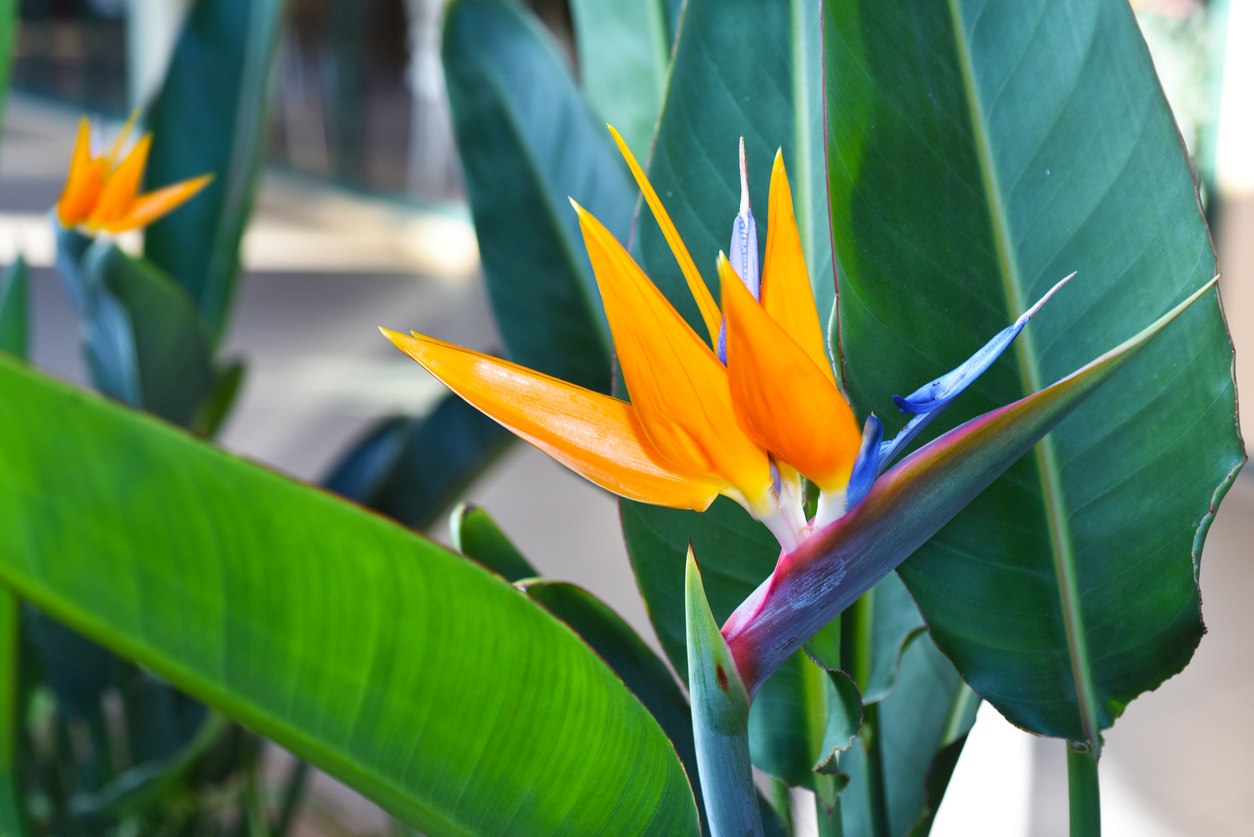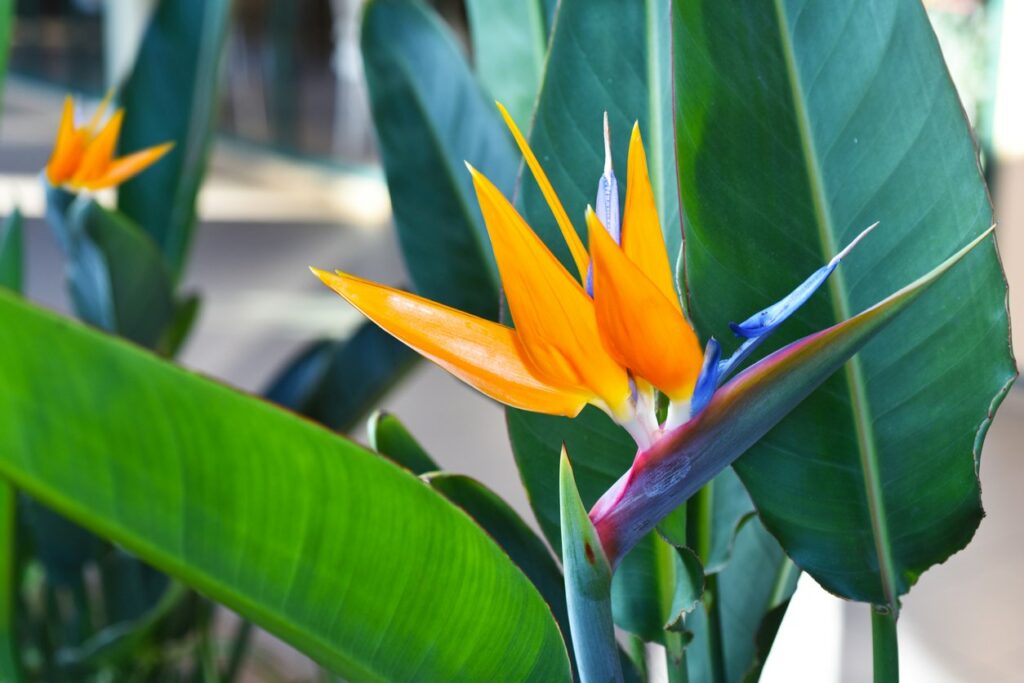Bird Of Paradise Care: How To Grow And Care For Bird Of Paradise Plants
Dubbed the queen of houseplants, the bird of paradise is undoubtedly a force to be reckoned with in the world of indoor plants. There’s something tropical and exotic about the upright stalks, the banana-shaped leaves, and the unique flowers that look like a crane.
Even the little slits and breaks in the long and curved leaves add some ornamental value to the magnificent bird of paradise. These aerodynamic slits help the leaves sway in the strong wind or rain without tearing or flying off. All in all, this is an ornamental plant that has many design benefits. So what are these benefits and how do you grow the bird of paradise plant in your home or garden?
Bird Of Paradise at a Glance
Bird of paradise (Strelitzia reginae) is an evergreen plant native to South Africa. It has other names as well including crane flower, bird’s tongue flower, and strelitzia. It is a small plant by any measure. Fully grown it will reach about 4.5 feet high and about 6 feet wide. That means you can grow it in the garden or indoors and it will fit snugly in any space you fit it in.
The leaves of this evergreen deserve all the praise they can get. They are long, slender, and curved just like a banana. The prevalent color of the foliage is gray-green all year round. Slits and tears occur naturally in the leaves as a defense mechanism against gusts of winds and rain. Rather than look out of place, those slits are quite decorative and create a dynamic flair to the swaying plants.
But it’s the flowers that steal the show and get all the attention. Raising a little over the foliage, the pointy flowers shimmer in orange and blue and different shades in between. The flower is tubular and the wrapped petals taper at the end. This gives it the shape of a crane or a bird’s tongue which explains the common names of the plant.
Bird Of Paradise Varieties
In general, there are three species of bird of paradise that occur naturally. So far there have been no cultivars in the market. It’s not clear why that is the case though. Unless horticulturalists had no hope of outdoing the natural species. Here are the three species.
- White-flowering strelitzia (Strelitzia nicolai): A giant of a plant as it can reach 30 feet when fully mature. This imposing height has a downside as it hides the blooms which open at the very top of the plant. The flowers are white but since you won’t see them, they don’t add much ornamental value to the plant.
- Rush-leaved strelitzia (Strelitzia juncea): A smaller plant than the previous species and that too reflects on the leaves. They are shaped like spoons and reach about 3 inches long and 1.5 inches wide.
- Small-leafed strelitzia (Strelitzia x parvifolia): Even though it’s called small-leafed, this strelitzia has leaves that exceed 6 inches long and 2 inches wide. Considering that the leaves stay on the plant throughout the year, you can imagine the design benefits of the foliage.
Landscaping with Bird Of Paradise
For a plant with such ornamental values, one can see how it will have a place in every yard, living room, and even public parks. Bird of paradise is the favorite evergreen in gardens all over Florida. If you walk down the sunny streets of Los Angeles, you’ll find its impressive flowers peeking at you from every corner. So much so that the crane flower has become the designated national flower of the city.
Many people grow this evergreen near swimming pools since it doesn’t give them an issue with fallen leaves or debris. The same thing applies to courtyards, tennis courts, and public parks. You can grow it either as an anchoring shrub or an accent plant where it serves its ornamental purposes fully.
And then, of course, you have floral arrangements. If the blooms look great on the plant, imagine what you can do with them in a vase. Known for their long lives, you can have the peeking flower blooming in your vase for up to two weeks at a time.
How to Grow Bird Of Paradise
You won’t need much experience to grow bird of paradise. It is easy to grow and apart from sunlight, it requires little work or attention from you. The easiest way to grow it is from seeds. Here’s you will do that in easy steps.
- The seeds of the plant will take up to a year to germinate. It will take a few more years before you see flowers on the fully grown plant. So patience is recommended.
- Give the seeds the water test to make sure they are healthy and will germinate. The last thing you’d want is to wait for a whole year to discover the seeds were not good.
- Soak the seeds for three days before planting. Discard any seeds that float to the surface. Don’t forget to change the water every day.
- Depending on the weather conditions you can grow the plant in your garden if you get between 50 and 75 degrees Fahrenheit all year round. Otherwise, consider growing it as a houseplant.
- You will need rich, loamy, and well-drained soil to grow this evergreen plant. Add about 4 inches of organic compost or bone meal to the soil and mix well.
- Fill a medium to a large container with the soil and make sure the container has plenty of drainage holes.
- Spread the seeds on the surface of the soil then cover them with a thin layer of soil.
- Water immediately to get the soil thoroughly wet. Avoid exposing the seeds.
- Keep the pot in a warm place away from direct sunlight or strong winds.
- Don’t let the soil dry out. Keep it moist throughout the first year until the seeds germinate.
- After the first few leaves appear, you can move the pot to a sunny spot or place it in a window in a very bright room.
Bird Of Paradise Care
With a lot of time and patience, your seeds will sprout into little seedlings. A few years later, the seedlings will flourish into a gray-green evergreen. About 5 years from the time you plant it, finally the exquisite flowers bloom for the first time. All that hard work and waiting have finally paid off. It’s time to sit back and admire this wonder of nature. And while you’re at it, also pay attention to feeding and watering the bird of paradise.
Soil
While it can grow in different types of soil ranging from the rich to slightly acidic and even neutral, it’s loamy soil that the bird of paradise really desires. Loamy soil is well-drained and is naturally fertile. Of course, you can add organic fertilizers or bone meal to any soil to enrich it. Just remember to test the pH levels in the soil before you grow especially in the garden. These levels should range from 5.5 to 7.5. Anything above or below that will not help these hardy plants bloom as abundantly as you’d have them.
Water
Many flowering plants, even the hardy evergreen types, need adequate irrigation. If you deviate even slightly from the norms they expect, they’ll make it known immediately in yellowing leaves or crestfallen flowers. This applies to bird of paradise more than any other evergreen. The plant needs moist soil regularly. Not wet nor dry soil. Just moist. If you overwater it or hold off the water long enough for the soil to go dry, the leaves will turn yellow. But once the plant matures (it takes up to 5 years for it to reach maturity) you won’t have to worry about keeping the soil moist. Allow the top three inches of the soil to go dry before you water it.
Mulch
Mulching is one of those basic skills that every gardener needs to master and appreciate its benefits. Cover the base of the bird of paradise with about three inches thick layer of mulch at all times. This keeps the soil moist, prevents the spread of weeds, and keeps pests from reaching the plant. You can use any organic mulch you have around the garden shed. Rotten leaves, pine needles, or shredded bark are all good candidates. Just make sure the mulch doesn’t touch the stem of the bird of paradise to avoid stem rot.
Pruning
Since you will have the bird of paradise in your garden or house for long years, you will have to do some pruning every now and then. You won’t be walking around with your pruning shears ready to snip and trim at will. However, you will still need to remove any dead leaves or fallen flowers that could attract fungus. Cut the flower stalk close to the stem to encourage the plant to grow new ones. Then you have to deal with clumps. The best way is to thin them out from the center to increase the airflow and prevent fungal infestation.
Pests and Diseases
Common pests such as snails, aphids, grasshoppers, scale, and caterpillars invade the bird of paradise and feed on the juicy sap in the leaves. But it’s mealybugs, whiteflies, and spider mites that really cause the most damage to the leaves. If it’s just a few insects of every species, you can use a piece of cotton soaked in rubbing alcohol to exterminate them. If it’s more than a few, you might have an infestation. Use neem oil to get rid of the pests safely and without damaging the environment or other plants in the vicinity.
As for diseases, you should watch out for the following.
- Bacterial Wilt: A disease that infects the roots of the plant since the bacteria that causes it lives in the soil. Symptoms include yellowing leaves followed by a wilting stem near the soil. The stem will turn brown or black before it begins to die. Remove all infected plants to prevent the spread of this fatal disease.
- Leaf Spot: A fungal disease that leaves spots in yellow, brown, or black on the leaves. The leaves then wither and die without leaving any further damage on the plant itself. Neem oil is effective against this fungal infestation.
- Gray Mold: It leaves a gray thin layer on the leaves and flowers which diminishes the beauty of this ornamental plant. The leaves will die and fall because of the disease. Avoid watering the leaves or flowers to prevent this disease and always remove infected leaves and dispose of them safely.

